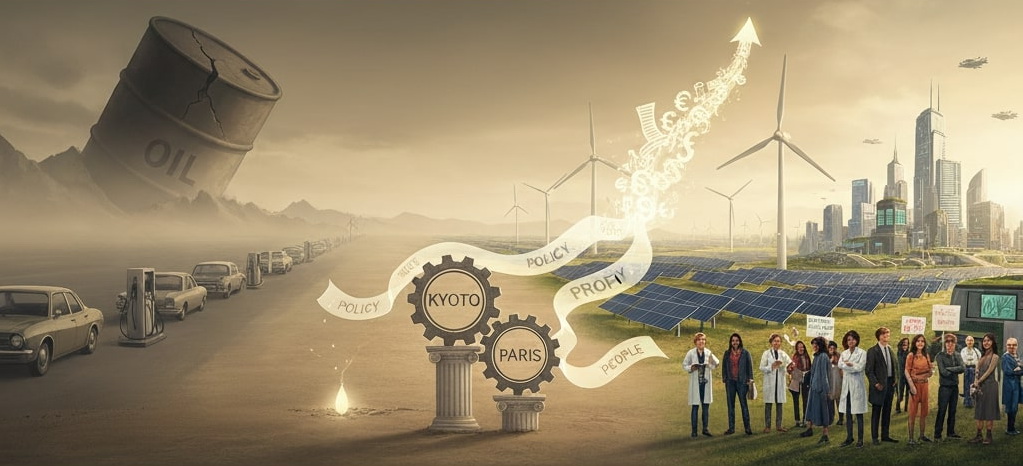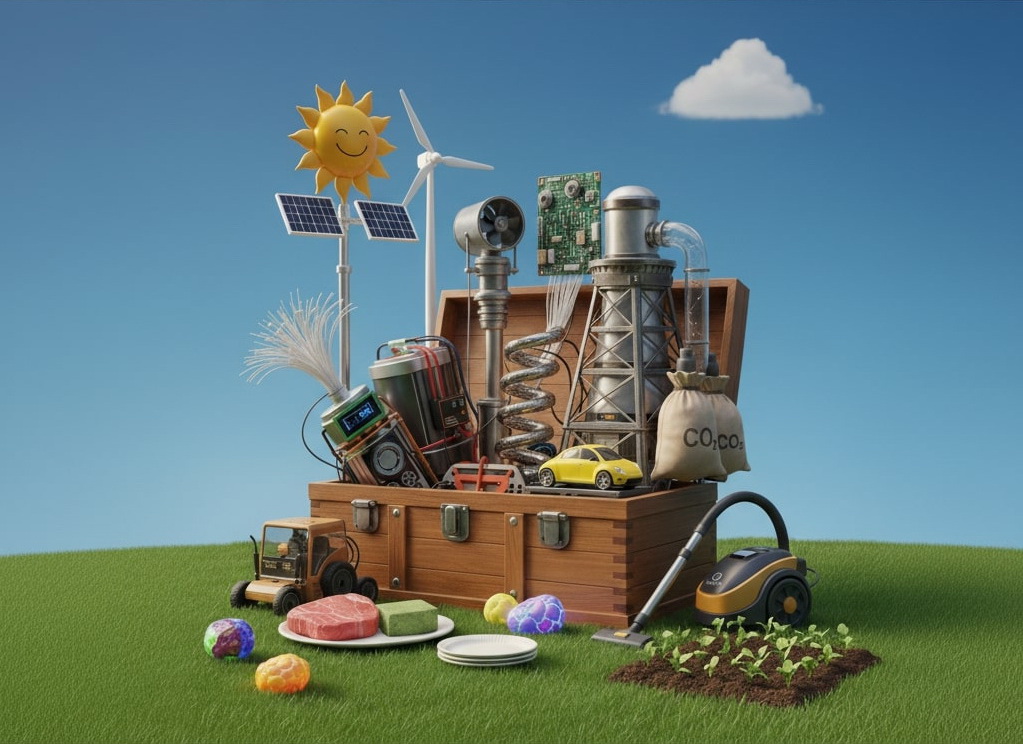Let’s get one thing straight: saving the planet isn’t just about hugging trees or sipping guilt-free from a paper cup. Trees are lovely. We like trees. But if you’re counting on a trillion saplings to reverse climate change while we keep cranking out carbon like it’s a hobby? That’s like trying to drain a bathtub with a spoon—admirable, but painfully slow.
Enter climate tech—Earth’s ultimate upgrade kit. It’s where solar panels date AI, carbon-capture machines hit the gym, and cows get fired because lab-grown meat doesn’t fart methane. It’s science fiction, minus the fiction (and the space battles… so far).
When your hamburger is grown in a lab and your shoes are made of mushrooms, you know the future’s here.
And here’s the kicker: this isn’t just science fiction or startup pitch decks. It’s sneaking into your life like a polite ninja. That silent electric car on your block? Climate tech. The sneakers that claim to be compostable? Weird, but yep.
Now, we’re not saying this tech will save the world overnight. But it’s fast, clever, and doesn’t ask for perfection—just progress. So where did it all start? What’s the wildest stuff coming next? And the million-dollar question: can clever machines fix what clumsy humans broke?
Welcome to 1000whats, where I mix science, sass, and a little bit of panic to make climate conversations worth reading.
What is climate tech?
Let’s play a game. Picture the planet as a giant laptop—one of those poor, overworked machines gasping under a hundred open tabs: fossil fuels, deforestation, factory farming, fast fashion, two-day shipping for things you didn’t need.
The fan’s screaming. The screen’s lagging. And no, blowing on it won’t help.
What we need isn’t just a new browser—it’s a whole new operating system. That’s climate tech.
At its simplest, climate technology (climate tech) is a collection of innovations designed to fight climate change.
Not in theory. In practice. Here’s what’s inside:
- Renewable energy like solar, wind, and geothermal—power that comes without an expiration date or a guilt trip.
- Carbon capture machines that straight-up vacuum greenhouse gases from the sky. Sci-fi? More like sci-fact.
- Green materials and circular economies that say, “Wait, maybe don’t throw that away just yet.”
- Smart grids and electrification that make our power systems less dumb and more nimble.
- Sustainable food tech like lab-grown meat and algae burgers—yes, algae. No, you don’t have to pretend to be excited (yet).
If it sounds like science fiction, that’s because yesterday it was. Today, it’s getting built.
Many of these ideas were once laughed out of the room—or stuck in the pages of dystopian novels.
Take direct air capture: machines that suck CO₂ right out of thin air. Ten years ago, that was plot material. Now? It’s got a patent number and a startup pitch.
Welcome to climate tech—where the wild ideas didn’t just survive. They got funding.
Why does climate tech matter?
It’s not just a tech trend. It’s our best shot at not turning Earth into a sauna.
So, why does climate tech matter now? Simple: the clock’s not just ticking—it’s practically yelling.
We’re inching dangerously close to the 1.5°C warming limit set by the Paris Agreement. Cross that line, and things start falling apart fast. We’re talking stronger storms, higher seas, and ecosystems collapsing like Jenga towers on a bumpy table.
But here’s the plot twist: the cavalry is arriving—and it’s wearing lab coats. According to Website Planet, the global climate tech market grew 23% in 2023 alone, reaching $20.34 billion.
And it’s not slowing down. Projections show it could hit $183 billion by 2033.
That’s not a trend line. That’s a launchpad.
It’s not magic. It’s math—and a bit of momentum.
Technology is a tool, not a savior
Still, here’s the honest bit: tech alone won’t save us. It’s like buying a gym membership. That shiny key fob doesn’t make you fit unless you actually go. And maybe ease up on the donuts.
Same goes for climate tech. We need smart policies, serious funding, and, yes, people who care enough to vote, build, and maybe eat the algae burger now and then.
Because without these tools, we’re fighting a wildfire with a garden hose.
With them? We’ve got a firetruck, a GPS, and a crew of engineers riding shotgun.
This is why climate tech matters. It gives us something humanity’s rarely had in a crisis: a fighting chance.
How did climate tech become a global priority?
Let’s rewind the tape.
Long before climate tech became the hottest buzzword since “blockchain,” the world was running on a different narrative: fossil fuels were the MVPs.
Coal lit the first factories. Oil fueled entire nations. Gas warmed homes and got people from point A to B. Fossil fuels built the modern age—and powered a whole lot of convenience.
But like every epic saga, there was a twist. A big one.
By the late 20th century, scientists raised the red flag.
Once upon a time, fossil fuels were the hero. Then the planet got a fever.
Burning all that fossil fuel was heating the planet like a microwave burrito. In 1988, the IPCC was born—basically the UN’s climate brain trust—and their reports said what no one wanted to hear: humans were cooking the planet.
Still, change came slower than a dial-up connection. Why? Because fossil fuels weren’t just an energy source. They were tangled into everything—economies, politics, jobs, even wars.
From crisis to catalyst: When innovation stepped in
Ironically, it was the 1970s oil crises that gave us a preview of the future.
Fuel shortages hit hard. People waited in long lines. Governments panicked. Suddenly, the world realized: depending on a few unstable sources for energy was a risky business.
This sparked the first real push into alternatives like solar and wind. Back then, the tech was clunky, costly, and barely competitive. But the seed was planted.
Then came the Kyoto Protocol in 1997 and the Paris Agreement in 2015. Climate change officially entered the global group chat. These treaties didn’t just wag fingers—they lit a fire under innovation. If countries had to decarbonize, someone had to invent the tools.
Enter the first generation of climate tech.
But what really supercharged it? Money.
Solar panel prices plummeted 90% since 2010. Wind got cheaper than coal. Suddenly, going green wasn’t just noble—it was profitable. Investors perked up. So did engineers, founders, and entire supply chains.
Nothing accelerates progress like a profit margin.
And let’s not forget culture.
Millennials and Gen Z weren’t just watching the planet heat up—they were organizing strikes, demanding action, and shaming companies into greener choices. Capital took the hint.
By 2022, climate tech investment had passed $100 billion. Startups sprouted everywhere—from carbon-sucking concrete to food waste sensors.
In short, climate tech went from fringe idea to economic juggernaut because four forces aligned: science, politics, markets, and people.

Which climate tech innovations are changing the game?
Picture the world in crisis. Heatwaves, rising seas, melting glaciers.
Now picture a team of technologies, each with its own superpower, assembling to fight back. Some are already out there doing the work. Others are still in their training montage. But together? They’re reengineering how we live, work, eat, and move.
Let’s meet the lineup.
If climate change is the villain, climate tech is the superhero squad we didn’t know we had.
Renewable energy — Sun and wind take center stage
Solar and wind used to be fringe experiments.
Now?
They’re the rock stars of energy. 🤘🏻
Solar panel prices have dropped nearly 90% since 2010. Offshore wind farms stretch across coastlines, generating clean electricity at mind-blowing scales.
This isn’t just about swapping coal for sunlight. It’s about rewriting the economics of energy, making clean power the cheapest option in many places.
Carbon capture — The planet’s vacuum cleaner
Imagine a massive air filter for the sky. That’s carbon capture.
It grabs CO₂ either from smokestacks or directly out of the air, then locks it deep underground.
It’s not cheap (yet), but for industries like steel and cement—where emissions are hard to avoid—it’s one of the few options on the table.
Want the full story on Carbon capture?
I unpacked it on 1000whats → https://1000whats.com/carbon-capture/
Smart grids — The internet of energy
Think of a power grid that doesn’t freak out when clouds block the sun.
Smart grids use digital tech to manage electricity in real time. They balance supply and demand, integrate renewables, and even chat with your fridge.
In short, they make the energy system as smart as your phone—and a whole lot more useful.
Electrification — From driving to dining
Electric cars get all the headlines, but electrification goes further.
We’re talking electric buses, heat pumps, induction cooktops, and more.
The mission? Replace anything that burns fuel with something powered by clean electricity.
The result: fewer emissions, cleaner cities, and quieter streets.
Dinner has entered the climate chat.
Innovations like lab-grown meat, AI-driven farming, and plant-based proteins are transforming food from footprint-heavy to future-friendly.
Given that animal agriculture contributes nearly 15% of global emissions, rethinking what’s on the plate is no small thing.

Green materials & circular design — Rebuild, rethink, reuse
Remember when recycling felt revolutionary? Now we’re talking products designed to be reused from the start.
Add in low-carbon cement, algae-based packaging, and biodegradable everything, and suddenly construction and consumption look very different.
This is the blueprint for a circular future—one where waste is a design flaw, not a given.
Green Hydrogen — The quiet wildcard
It’s made by splitting water using renewable energy. It doesn’t emit carbon. It could power ships, factories, and even airplanes. That’s green hydrogen.
It’s still pricey, but governments and investors are betting big. If the costs drop, this fuel could fill the gaps batteries can’t.
No single fix—but a serious arsenal
Each of these innovations solves a piece of the puzzle.
Alone, they’re impressive. Together, they’re how we turn the tide.
They give us something rare in a crisis: momentum, creativity, and a fighting chance.
One gadget won’t fix the climate. But a whole toolbox might.
Can climate tech really cut emissions fast enough?
Here’s the million-dollar (or rather, multi-trillion-dollar) question: can climate tech scale quickly enough to keep global warming below dangerous levels?
The short answer? Yes. But only if we stop strolling and start sprinting.
The clock is ticking
Scientists say we must slash global emissions nearly in half by 2030 to stay within the 1.5°C safety zone.
That’s not abstract. That’s a deadline measured in months, not lifetimes.
Yet emissions are still rising, fueled by coal plants, oil habits, and a growing hunger for energy. Climate tech could bend that curve. But it needs to move at the speed of crisis, not convenience.
The good news? Some tech is already punching above its weight.
- In many places, solar and wind are now cheaper than coal or gas.
- Electric vehicles are expected to outsell fossil-fueled ones in several countries within a decade.
- Battery storage is advancing fast, making renewables more reliable and grid-friendly.
- Even carbon capture—once seen as science fiction—is pulling thousands of tons of CO₂ from the air and stuffing it underground.
Progress is real, but the clock is realer
Here’s the rub: scaling all this is like changing a jet engine mid-flight.
The global economy is still tangled in fossil fuels. Switching it over takes time, money, and political will—three things often in short supply.
Some perspective:
- As of 2022, there were about 44,595 climate tech companies worldwide. That number could reach 66,500 by 2030. Impressive, but still dwarfed by the size and sway of the fossil fuel industry.
- In 2023, climate tech funding fell to $72.9 billion, down from over $100 billion the year before. That shows interest—but also fragility.
So yes, the tools exist. But the scale-up isn’t just a technical challenge—it’s a logistical and financial sprint.
Why optimism isn’t a delusion
Forget silver bullets. This is a job for toolkits.
Solar panels can’t clean up heavy industry. EVs can’t green agriculture. But put them all together—and they start pushing emissions down from every angle.
Progress might look slow in the moment. But fast-forward ten years, and these innovations could quietly rewrite our energy story.
The real question isn’t whether climate tech can do it.
It’s whether we’ll let it.
There’s no single fix—but a thousand small ones, firing all at once, just might do it.
What’s holding climate tech back?
Climate tech sounds exciting—and it is. But under the glossy surface of solar panels and smart grids, there’s a long list of challenges dragging their feet.
Let’s take a look at what’s really slowing the revolution down.
Climate tech isn’t a silver bullet. It’s a toolkit—one that still comes in a box labeled ‘some assembly required.’
High costs and the “Valley of Death”
Some of the most promising tech—carbon capture, green hydrogen, next-gen batteries—still come with sky-high price tags. It’s like inventing a flying car… and realizing no one can afford the runway.
Even mature solutions like wind and solar need serious investment to scale—land, permits, labor, logistics.
And startups? Many stall right between “cool prototype” and “global rollout.” That gap is so deadly, the tech world calls it the valley of death.
Infrastructure that isn’t ready
A solar-powered car is great—until you can’t find a charger. Smart grids are brilliant—if the old wires don’t catch fire first.
Climate tech depends on infrastructure that, frankly, isn’t always up to the task. Charging stations, transmission lines, storage systems—we need to build the roads before the cars can drive.
And that’s before we even talk about global logistics, rare minerals, or supply chain bottlenecks.
Policy ping-pong
Government support can light the fuse—or douse the flame. Clear rules, tax credits, and carbon pricing help tech grow. But shift the political winds, and entire sectors can stall overnight.
This whiplash doesn’t just scare voters. It terrifies investors. Long-term planning is hard when the rules change every election cycle.
Unequal playing fields
Not every country can afford to pour billions into solar farms or green steel. While wealthy nations race ahead, many developing regions are stuck choosing between power outages and pollution.
The people least responsible for climate change are often hit the hardest—and left with the fewest tools.
And yet—they’re also the ones most vulnerable to climate chaos. Bridging that gap is about more than fairness. It’s about making solutions that work everywhere, not just in boardrooms and tech hubs.
Mind the (behavior) gap
Tech can’t save the planet if people refuse to use it.
Some drivers fear EVs will run out of charge. Others think carbon capture is a greenwashing trick. Many just default to convenience, even when better options exist.
Changing tech is only half the battle. Changing behavior is the other half—and it’s the harder one.
Fossil fuels: The shadow that won’t quit
Fossil fuels aren’t just old—they’re entrenched.
Coal, oil, and gas still receive massive subsidies in many countries. That creates an uneven playing field where clean tech has to fight not just science, but politics, profits, and 100 years of habit.
These industries aren’t going quietly. They’re lobbying, advertising, and adapting—sometimes even co-opting the green message.
Why this all matters
Facing these challenges isn’t about being pessimistic—it’s about being prepared. Each roadblock reveals where the system needs pressure, policy, or innovation.
Because we don’t need perfect tech. We need resilient strategies—and a willingness to keep going even when the road’s uphill.
If climate tech is the toolkit, these are the locked doors we need to pry open.

Want to dig deeper into the numbers?
If this post sparked your curiosity about the hard stats behind climate tech, I highly recommend checking out the excellent roundup at Website Planet: Climate Technology Statistics.
It’s packed with up-to-date figures on market growth, investments, and innovations shaping the future. Think of it as your data-rich companion to the big-picture narrative we’ve explored here.
Final thoughts
Let’s be real: climate tech sounds like a sci-fi subplot.
Solar farms in deserts, meat without mooing, AI-powered farms, electric everything. At times it feels like the planet got a software update while we were still figuring out our smart fridge.
But here’s the kicker—it’s happening.
Right now.
And it’s not just a tech story. It’s a human one.
Climate tech is messy, bold, and occasionally smells like algae. But it’s also one of the greatest opportunities of our generation. It can clean our air, power our cities, and maybe—just maybe—buy us time to stop setting the place on fire.
Will it be easy? No. Will it be worth it? Absolutely.
And the best part? The story isn’t finished. And you’re in the cast.
This isn’t just about saving the planet. It’s about upgrading it—without crashing the system halfway through.
So… what’s your plot twist?
You don’t have to invent carbon-neutral rocket ships or live in a house made of mushrooms (though, respect if you do 😄).
Maybe you’re installing solar panels. Maybe you’re eating more plants. Or maybe you’re just yelling at your city council to install bike lanes and stop paving over everything.
Whatever your angle, you’re already in the climate tech story.
So now it’s your turn:
- What climate tech gives you hope—or just makes you go, “Wait… that’s real?”
- Should we be taxing fossil fuels like bad habits or throwing more money at clean tech?
- How do you imagine climate tech reshaping your world by 2035?
- What totally wild idea do you think will go from “that’s insane” to “wow, it works”?
Drop a comment, share a dream, or start a debate. Just don’t sit this one out—we’ve got a planet to reprogram.
Until next time: stay curious, stay scrappy, and keep the batteries charged. 🌍⚡



